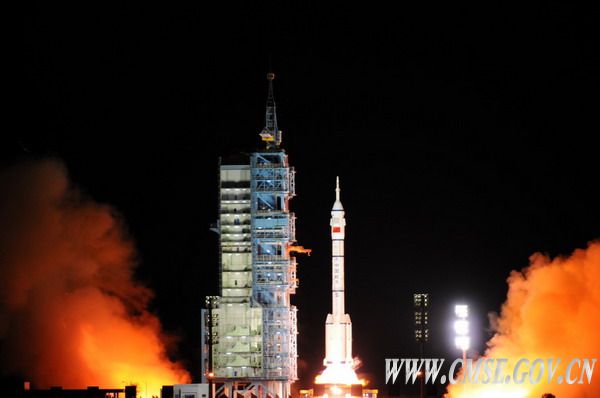China Set for Historic Space Docking Wednesday

A robotic Chinese spaceship is chasing down another vessel for a scheduled orbital meet-up Wednesday (Nov. 2) that could help clear the way for China's planned space station.
The unmanned Shenzhou 8 spacecraft launched yesterday on a mission to locate and latch onto the prototype space lab Tiangong 1, which has been circling Earth since late September. The historic space docking, which would be a first for China, is due to occur sometime Wednesday Eastern Daylight Time (which might make it Thursday local time in China), officials have said.
The main goal is to test out technologies that China will use to assemble a space station in orbit, which the nation hopes have operational by 2020.
"Unlike the U.S. which started with manually flown dockings, China is attempting an automated docking first and then manned dockings," Aerospace International editor Tim Robinson said, according to the Chinese state news agency Xinhua. "This probably reduces the human risk to crew, but it is also very ambitious."
Meeting up with Tiangong 1
Wednesday's robotic docking will require a series of intricate maneuvers, some of them directed by engineers on the ground and some performed autonomously by the spacecraft. [Shenzhou 8: Photos From China's 1st Space Docking Test]
For example, ground control will order five orbital maneuvers to get Shenzhou 8 in the same neighborhood as Tiangong 1. But once Shenzhou 8 gets to within about 30 miles (50 kilometers) of the space lab, the newly launched ship's onboard sensors will take over, Xinhua reported.
Breaking space news, the latest updates on rocket launches, skywatching events and more!
These sensors will guide Shenzhou 8 the rest of the way automatically, in a slow and delicate approach that will take about two and a half hours. The docking itself — the locking of metal on metal — should take an additional 15 minutes, according to Xinhua.
The two spacecraft will then remain attached for the next 12 days, zipping around Earth together under Tiangong 1's control, Chinese officials said. When those 12 days are up, Shenzhou 8 will detach, retreat to about 460 feet (140 meters) away, then dock again, to prove the first time wasn't a fluke.
After this second docking, the two vessels will remain joined for just two days. When that time is up, Shenzhou 8 will unhook itself again, this time for good. It will move to about 3 miles (5 km) away and prepare to end its mission.
"The re-entry module of Shenzhou 8 spaceship will return to the Earth, and Tiangong 1 will ascend to an autonomous flight orbit and convert into long-term operation management mode," China's Manned Space Engineering office spokeswoman Wu Ping told reporters shortly before Shenzhou 8's launch, according to a translation provided by the office.
Tiangong 1 will await two more Shenzhou docking missions, which are slated to launch before the end of 2012. At least one of those missions — which are called Shenzhou 9 and Shenzhou 10 — will be manned, Chinese space officials have said.
A future space station
The Shenzhou docking missions are seen as key milestones along the path to building a space station in orbit. China hopes to have a 66-ton station up and running by 2020. (The International Space Station weighs about 430 tons.)
The effort is part of China's ambitious human spaceflight plans. It is just the third country, after Russia and the United States, to develop spacecraft capable of flying humans to space and back. China has launched three manned space missions, one each in 2003, 2005 and 2008.
All of China's spaceflyers to date have been men. But that could change on one of the next Shenzhou docking missions. Two female "taikonauts" are currently believed to be on China's active duty roster, Xinhua reported. [Most Extreme Human Spaceflight Records]
"We must assess both male and female astronauts to verify if human beings can live in space, as there are huge differences between men and women in spite of their common generalities," said Chen Shanguang, director of the Astronaut Center of China, according to Xinhua. "Space exploration activities would be incomplete without participation of female astronauts."
You can follow SPACE.com senior writer Mike Wall on Twitter: @michaeldwall. Follow SPACE.com for the latest in space science and exploration news on Twitter @Spacedotcom and on Facebook.

Michael Wall is a Senior Space Writer with Space.com and joined the team in 2010. He primarily covers exoplanets, spaceflight and military space, but has been known to dabble in the space art beat. His book about the search for alien life, "Out There," was published on Nov. 13, 2018. Before becoming a science writer, Michael worked as a herpetologist and wildlife biologist. He has a Ph.D. in evolutionary biology from the University of Sydney, Australia, a bachelor's degree from the University of Arizona, and a graduate certificate in science writing from the University of California, Santa Cruz. To find out what his latest project is, you can follow Michael on Twitter.

